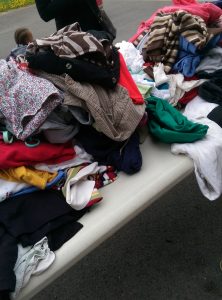Earlier this semester, I had participated in helping out with preparing diaper packages to give away to needy families at Catholic Charities. The expected time commitment was fairly long (about 4 hours) and the turnout was really low (2 residents and the sponsoring GRF). With this chance to volunteer, I thought that the turnout would be higher because not only were the shifts shorter (2 hours), there was one that started later in the day (not before 9 AM). Unfortunately, the turnout was still low this time around, with only 3 residents signing up for the first shift, and none for the second. I strongly encourage those living in Rose next year to sign up for volunteering events too, and not just the ones that are low commitment and impact.
This time around, we weren’t the only group helping out. While we interacted with Liddy again, we were among several other volunteers from organizations like Kohl’s Cares. Instead of walking through the building to get to the basement, we entered from behind the building and brought out bags of clothing. We then folded them on the table and tried to organize the large variety of donated items, despite the warnings from the experienced volunteers that any organization would soon be ruined by people rifling through the many options.
I was surprised by the turnout of the people looking forward to the Free Sale. Liddy mentioned that this has not yet been a long-running event, but with the amount of people looking for clothes and the many donated items they had in the basement, it seems like a good chance to distribute things out to those who need them. A lot of the people were mothers who had brought their children along. It was a little hard to see our somewhat sorted, folded clothes being tossed around, but it was nice to see that people were able to find what they wanted. There were several little kids running around, and there was one little girl who especially liked hugging things (including my leg once) and was really happy to find a cute dress that was her size that she could hug. Another memorable moment was the reaction of one little girl to a sweater that GRF Magdala handed to her, because it was just what she wanted.
The idea of a free sale from a bunch of donated items that are just asking to be given to someone who needs them is great, and it was a concept I hadn’t heard of before. It was a great chance to interact with people around Ithaca who aren’t part of the campus community, especially because the kids there had genuinely excited reactions to something as small as a piece of clothing. To end this, I want to reiterate that the turnout for these volunteering events has been pretty low this semester, but it really isn’t a big time commitment and it’s definitely a good feeling to help others – so in the future, definitely sign up more for Rose House volunteering events!
^ Reasonably well-maintained table of clothes at the end of our volunteer shift

